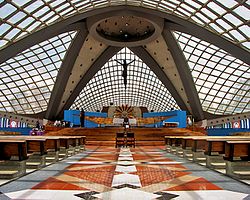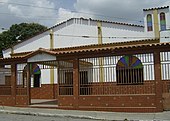Religion in Venezuela
- Catholicism(72%)
- Protestantism (8%)
- No religion (14%)
- Others (6%)

Overview
The influence of the
There are small but influential
The Church of Jesus Christ of Latter-day Saints (Mormons) claims 173,125 members (April 2022) mostly in and around Caracas.[6]
Venezuela is also notable for its significant
In Venezuela, a population of
| Affiliation | % of Venezuela population | |
|---|---|---|
| Christian | 88 | |
Catholic
|
71 | |
Protestant and other Christians
|
17 | |
| Other faiths | 3 | |
| Santería | 1 | |
Atheist
|
2 | |
| Agnostic/indifferent | 6 | |
| Don't know/refused answer | 1 | |
| Total | 100 | |
Religious freedom
The constitution of Venezuela provides for the freedom of religion insofar as it does not violate "public morality or decency". A 2017 constitutional law criminalizes "incitement to hatred" or violence, including provisions specifically concerning the incitement of hatred against religious groups.[10]
Religious organizations must register with the government in order to obtain legal status. The
Religious education is allowed in public schools, although it is not part of any official curriculum proposed by the government.[10] In the past, representatives of the Catholic Church-affiliated National Laity Council have claimed that the government has at times pressured school administrators to not teach religious courses, but that in other cases teachers had autonomy to include religious education as long as their curricula were otherwise compliant with the Ministry of Education's standards.[11]
Leaders of religious organizations who are vocal critics of the government faced verbal harassment by regime leaders. Jewish community leaders have accused state-funded media and some government officials of engaging in antisemitic rhetoric.[10]
In 2023, the country was scored 3 out of 4 for religious freedom.[12]
Catholic Church in Venezuela
The Catholic Church in Venezuela has around 31 million faithful, which represents 98% of the population. There are 37 jurisdictions present including 25 dioceses, 9 archdioceses, 3 vicariates apostolic, plus separate jurisdictions for the Melkite and Syrian rites, and also a military ordenate.
The Catholic manifestations in Venezuela are very varied, which means that in many regions they venerate a Marian dedication or a specific saint, as well as the realization of various fairs, masses, processions and parties for each patron saint of Catholicism. In this way, for example, in Zulia the Chinita Fair is celebrated, in Nueva Esparta the Virgen del Valle is celebrated and in Lara, the Divina Pastora is celebrated.
Protestant Churches in Venezuela


Motivated by poverty and in search of a better future, hundreds of thousands of
In
The spread of evangelical proselytizing was organized into different regions by diverse pioneer works:
| Region | Early pioneer missions and denominations |
|---|---|
| Western region: Zulian region, Andean region and South-Western region | Scandinavian Alliance Mission of the Evangelical Free Church of America
|
| Central-Western region | German-American Evangelical Pentecostal Holiness movement[19] which mostly merged into Assemblies of God, and Baptist Church mainly associated to the Southern Baptist Convention .
|
| Central region | The Swedish Evangelical Free Church of U.S.A. |
| Capital Region | Presbyterian )
|
| Guayana and Amazona region | Baptist Mid-Missions |
| Eastern region: Anzoategui, Sucre, Monagas, and Margarita Island | The Evangelical Alliance Mission[20]
|
| Los Llanos region | In Guarico: The Swedish Evangelical Free Church of U.S.A. In Apure: Baptists which merged into Native Church |
The Christian-Evangelical Churches of Venezuela, today, are mainly segmented into six major branches:[21]
| Protestant or Evangelical branch | % |
|---|---|
| Assemblies of God
and other Pentecostals groups |
60 % |
| Baptist Churches: | 16 % |
| Plymouth Brethren Church | 9 % |
| Seventh-day Adventist Church | 4 % |
| Evangelical Free Church | 2 % |
| United Pentecostal Church | 1 % |
Other Evangelical Christian Denominations across the country
- Evangelical Foursquare Church
- Methodist Groups like: Free Methodist Church, and the United Methodist Church
- Wesleyan Church
- Evangelical Mennonites
- Church of God (Pentecostal)
- Church of God of Prophecy
- Church of the Nazarene (Holiness movement)
- Church of God Ministry of Jesus Christ International (Neopentecostal)
- Church of Christ
- Christ Apostolic Church
Eastern Orthodoxy in Venezuela


The Eastern Orthodox Church in Venezuela has existed in Venezuela with the purpose of satisfying the spiritual needs of this religious groups, mainly made up of Russian, Yugoslav (Serbian, Croat and Bosnian) immigrants who arrived in the country since the end of World War II. It does not obey a planned system of religious proselytism, since church services were held in the immigrants' languages. Added to that group are the Greeks, Romanians[22] and Ukrainians,[23] who with the passing of the decades their descendants have maintained that faith in the country.[24]
Hinduism in Venezuela
During the oil-related high-income years of the 1970s, there were around 400 non-resident Indians in the country. There are also several thousand of
The Indian community consisted of personnel from the petroleum and petrochemical sectors, as well as a large number of traders. Many of them had taken their families with them to Venezuela, whether from India or elsewhere. Most of the traders belonged to the
When the oil boom ended in 1982, followed by devaluation of the local currency, many of the non-resident Indians decided to seek their fortunes elsewhere. Currently, the Diaspora has been whittled down to half its former size. There are now only about 45 Indian families in Venezuela who are mainly engaged in retail trade. There are also a small number of experts in high tech. industries such as telecommunications.
All of them have adapted themselves very well to their country of residence and are generally held in high regard by the local people on account of their hard work, expertise and non-political nature.
The Venezuelan Constitution guarantees equal rights without discrimination to all expatriate personnel. This has facilitated the Indian community's life.
Another interesting feature is that many local people are interested in Indian religions and spirituality.
Some members of the Indian community also attend their functions. Most of the non-resident Indians are well educated. However, given their small numbers, they have not formed themselves into an active representative body. But they remain in touch with one another and with the Indian Embassy in Caracas. Even though they have little time to engage in numerous cultural activities, they do get together to celebrate Indian festivals like Diwali.
On the whole, the Indian community in Venezuela is quite prosperous and has a per capita income that is above the national average that is itself as high as US$8,300 in terms of PPP. They take an active part in mobilising donations to help in alleviating distress at times of national calamities in India.[citation needed]
In 2010, there were 580 Hindus in Venezuela according to the Association of Religion Data Archives.[25]See also
References
- ^ "Latinobarometro_Informe_2024" (PDF). 2024.
- ^ a b Aguire, Jesus Maria (June 2012). "Informe Sociográfico sobre la religión en Venezuela" (PDF) (in Spanish). El Centro Gumilla. Archived from the original (PDF) on July 1, 2014.
- ^ a b Khalifa, Mustafa (2013), "The impossible partition of Syria", Arab Reform Initiative: 6–7, archived from the original on 2016-10-09, retrieved 2018-08-02
- ^ Sesin, Carmen (July 18, 2017). "As crisis deepens, more Venezuelans are emigrating to Lebanon". NBC News. Archived from the original on April 9, 2022. Retrieved April 8, 2022.
- ^ a b Bavly, Ofer (April 6, 2021). "Sending relief--and a message of inclusion and love—to our Druze sisters and brothers". Jewish Chicago: The JUF Magazine. Retrieved April 8, 2022.
- ^ N., Guillermo Estrugo. "Facts and Statistics: Venezuela". Mormon Newsroom. Retrieved 11 Apr 2022.
- ^ "2020 Country and Territory Reports". Jehovah's Witnesses. 2020. Archived from the original on April 9, 2022. Retrieved April 8, 2022.
- ^ "Santeria surges in Venezuela - World news - Venezuela". NBC News. 2008-02-08. Retrieved 2013-02-18.
- ^ "Hasta 40 mil bolívares cuesta hacerse "El Santo"". Ultimasnoticias.com.ve. 2012-08-28. Archived from the original on 2013-01-16. Retrieved 2013-02-18.
- ^ a b c d US State Department, 2022 report on Venezuela
- ^ International Religious Freedom Report 2017 § Venezuela, US Department of State, Bureau of Democracy, Human Rights and Labor.
- ^ Freedom House website, retrieved 2023-08-08
- ^ "Resumen del nacimiento de las iglesias libres en estados unidos y latinoamerica - Resúmenes - Abdy Benjamin Pereira Cazorla".
- ^ "La inmigración en Estados Unidos, una historia de éxito". 19 July 2020.
- ^ "HISTORIA – ADIEL – Perú". Archived from the original on 2022-02-06. Retrieved 2025-02-20.
- ^ "La Reforma Protestante y los Evangélicos en Venezuela". 30 October 2021.
- ^ Heartland Prairie
- ^ Venezuela
- ^ Bletscher, Robert D. (May 1950), The Extent and Influences of the Holiness Revival in America, 1860-1900 (en línea),
One denomination, the Evangelical Association...was similar in doctrine to the Methodist Church but, because of difficulties involving the preaching of the gospel in the German language, Jacob Albright and his co-laborers thought it best to establish their own denomination. During the nineteenth century, the Evangelical Association was probably one of the outstanding holiness churches in America.
- ^ Regions
- ^ "Informe sociográfico sobre la religión en Venezuela" [Sociographic report on religion in Venezuela] (PDF). www.gumilla.org (in Spanish). Archived from the original (PDF) on 7 June 2020. Retrieved 22 February 2022.
- ^ "Iglesia de San Constantino y Santa Elena – Iglesia Rumana Ortodoxa | el Hatillo Virtual 360°".
- ^ Calendar 2015 Orthodox Daily Planner
- ^ "Venezuela – Iglesia Ortodoxa Antioquena".
- ^ "Most Hindu Nations (2010)". QuickLists > Compare Nations > Religions >. The Association of Religion Data Archives. 2010. Archived from the original on April 10, 2016. Retrieved February 20, 2022.
